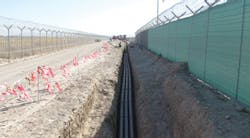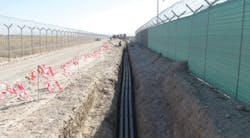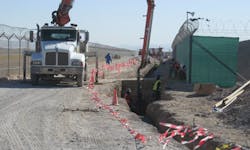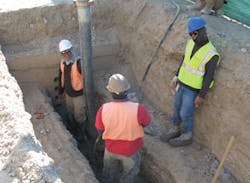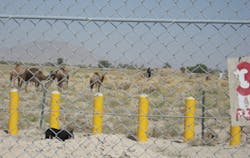Cabling the way forward in areas of conflict
From the February, 2013 Issue of Cabling Installation & Maintenance Magazine
After United States forces withdraw, a communications infrastructure is one legacy left behind in areas such as Iraq and Afghanistan. Here's the story of one contractor engineering such infrastructure.
By James A. Bailey, Mission1st Group
With the drawdown of American forces in Southwest Asia, and amid sweeping changes taking place in areas of conflict, it is still true that there is a critical need to provide secure communications for the American warfighter throughout these volatile regions of the planet. This task falls to system engineering and technical assistance (SETA) contractors, like Mission1st. Project manager force projection (PMFP) is the framework organization in which we support the efforts of the Assistant Secretary of the Army. The focus and mission of PMFP enablers is the ongoing role of providing vital communications to the American warfighter.
We place seasoned telecommunications specialists in war zones, downrange, implementing the Army's requirement of standards-based, enduring telecommunications systems. With speed of executive, life support and the management of logistics, we have many times shown "the way forward" in these war zones.
To all those who have designed or installed communications systems in various environments, imagine these scenarios. Many SETA contractors do not have to imagine them because we have lived them.
It is past midnight. The blast from the indirect fire (IDF) rocket lifts your bed and rearranges your room. It also hits the technical control facility (TCF) and a good portion of your base communications is down at the moment.
The concentric-ring fiber for all of your enclaves has not been properly identified. The excavator--with stunning accuracy--finds it and shatters the glass fibers 20 feet in both directions.
You take a call in the middle of dinner hour at the dining facility, letting you know an alarm has come in from the most-remote node shelter indicating the fuel generator has run out.
These are all-too-real events here in "the forward." What is ever-evident, though, is the professionalism displayed by the on-site crews in events such as those described above. In each circumstance the problem was analyzed, proper action was taken and restoration efforts begun. Not unlike natural disasters that befall the United States telecommunications infrastructure, the war-zone infrastructure must endure regardless of the cause--be it natural or enemy attack.
The ongoing support of telecommunications covers several areas of discipline, from civil works to logistics. In each area, a clear design is necessary, and that design must be engineered properly to render the intended result. Taking into account the significant scope and scale of the task at hand, the proper design, engineering and implementation of such a system is the baseline, or building block, for meeting the high expectations of the United States Army telecommunications systems downrange.
Acquiring the project
The process by which a project is acquired and begins may differ from those in the civilian realm. The order process starts with the requesting command routing a project request memorandum to the theater signal command. This memorandum is then vetted by the project management force projection enabler (PM P2E) for merit, and sent back to the forward for design. The design is the critical phase, during which an engineering design plan is written and criteria established. Outside plant (OSP) elements such as maintenance-hole dimensions, grounding, splice-case and PVC conduit types are specified. Inside plant (ISP) elements like switching equipment, enclosures, HVAC and generator units are worked into a functional architecture.
The drawing package--an AutoCAD drawing with standards-based descriptors and work locations--is designed and given to the potential integrator of the project plan, to conductor their initial site visits and bid the project.
The bid process is carried out by the government contract office; selection is made based on specific criteria. The acquisition process is a combination of factors: 1) the contract vehicle being either a cost-plus or fixed-firm pricing contract; 2) integrator experience and past performance; 3) price quote submitted to the government. When the contracting officer reviews and approves these items, the project moves forward.
Downrange--The forward
The project downrange starts with a kickoff meeting between the integrator's site lead and the government SETA contractor project manager. A chain of custody is established and signed. Each party must clearly understand and agree on the contractual responsibilities in the areas of life safety, housing, material and manpower. An action plan for a successful project is established and the next phase of the project begins.
The working environment can be some of the most challenging an integrator may face. They will be working in a mountain-range plateau at 5,000 feet, summer temperatures of 120 degrees Fahrenheit, and winters that freeze the ground as hard as steel 6 feet down. The team is under constant threat of attack and the work never stops, year-round.
Language can be another challenge. The jobsite includes third-party nationals from India, the Philippines, Pakistan and Thailand. Local Afghan labor speaks Pashto and/or Dari. It all adds up to the project team's responsibility to get it right the first time.
Getting supplies for the project can also be a major challenge. Political, local and national events and conditions in Afghanistan result in frequent delays, which must be accounted for in the project plan. Heavy construction is performed by local workers, third-party nationals and U.S. equipment operators on backhoe, crane and civil works.
The goal is to provide a secure, hardened environment for the fiber-optic and copper communications cables, known as a protected distribution system (PDS). Concrete maintenance vaults are moved to the work site, buried 12 feet in the earth and placed in the field as protection for the vital communications passing through the communications system. These maintenance holes must withstand weights of 40,000 pounds on their lids.
Concrete encasement is essential to the project, and all PVC conduit runs between maintenance holes must be encased. Each day of a concrete pour, a truck arrives and samples of the mix are inspected for consistency. Once the material is approved, the pour begins. Each run encases a 2-, 6- or 12-way 4-inch PVC pipe, spaced properly to a hardness of 3,000 to 5,000 pounds per square inch. This pressure and the depth to which the system is buried ensure protection against heavy-equipment traffic as well as the worst-case scenario--a rocket attack on the OSP facility.
As an Installation Information Infrastructure Modernization Program (I3MP) standards engineering firm, Mission1st is required to engineer up to the end-user building (EUB) and/or provide enclave network communications to a secure space within the EUB. The grounding of the equipment to a telecommunications main grounding busbar, and the driving of a ¾-inch copper ground bar, assures that communications equipment will be at the same potential and not cause harm or be destroyed by lightning or electrical surge.
Enduring technology
Many factors weigh on the legacy of the communications infrastructure that is left in areas of conflict once U.S. forces are gone. Although there will be ongoing support activity that requires a communications system connecting to the outside world and capable of handling a certain amount of traffic, questions remain about how viably the system will be maintained. The OSP and ISP have been engineered to a 40-year standard. Engineering companies working with the U.S. government to deliver state-of-the-art communications systems for warfighters have been, and will continue to be, the way forward. ::
James A. Bailey, RCDD is an outside-plant and inside-plant engineer with Mission1st Group Inc. (www.mission1st.com), a systems engineering and technical assistance contractor. Bailey authored this article from Kandahar, Afghanistan.
